Alison Stokes and Christopher Aitchison* present diverse perspectives on accessible geoscience fieldwork
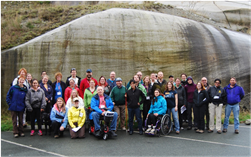 All learners, regardless of their stage of education, should see geoscience as an accessible academic subject offering viable career opportunities. For those with disabilities, however, the often rigorous programme of fieldwork required by undergraduate degree programmes can present physical and psychological challenges that deter participation1.
All learners, regardless of their stage of education, should see geoscience as an accessible academic subject offering viable career opportunities. For those with disabilities, however, the often rigorous programme of fieldwork required by undergraduate degree programmes can present physical and psychological challenges that deter participation1.
Picture: Participants in the Sea-to-Sky Highway accessible fieldtrip.
By signing the Science Council’s ‘Declaration on Diversity, Equality and Inclusion’, the Geological Society of London (GSL) has committed to enhancing the diversity of talent attracted into the geosciences. One key to achieving this is to provide greater opportunities for learners with disabilities to participate in accessibly designed field experiences.
A recent one-day fieldtrip conducted during the 2014 Geological Society of America (GSA) annual meeting in Vancouver was attended by 35 geoscience students and academics, almost half of whom (17) self-disclosed a physical, sensory or cognitive disability. Together they explored the feasibility and potential for both designing and conducting accessible fieldwork.
Picture: Typical scenery of the Vancouver region
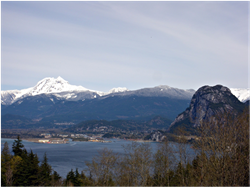 This particular fieldtrip successfully demonstrated that, with the necessary planning and organisation, it is possible to develop and deliver geology fieldwork that is inclusive of learners with a wide range of disabilities, while retaining a high degree of intellectual rigour and the capacity to deliver learning outcomes similar to ‘traditional’ fieldwork.
This particular fieldtrip successfully demonstrated that, with the necessary planning and organisation, it is possible to develop and deliver geology fieldwork that is inclusive of learners with a wide range of disabilities, while retaining a high degree of intellectual rigour and the capacity to deliver learning outcomes similar to ‘traditional’ fieldwork.
The idea of delivering a fully accessible field experience for both students and academics with disabilities was developed by Christopher Atchison (University of Cincinnati), whose 2011 study2 involved mobility-impaired undergraduate and postgraduate students in a cave and karst field experience at Mammoth Cave National Park, Kentucky. The 2014 ‘Sea-to-Sky Highway’ accessible field course was modified from a one-day introductory-level fieldtrip originally developed by Brett Gilley at the University of British Columbia, and focused on exploring the geology exposed along British Columbia’s famous Highway 99. The critical difference between these two excursions was the inclusion of academics as co-participants. This enabled students and instructors to work together in partnership, and explore first-hand how learners with different disabilities can be accommodated in a geological field setting.
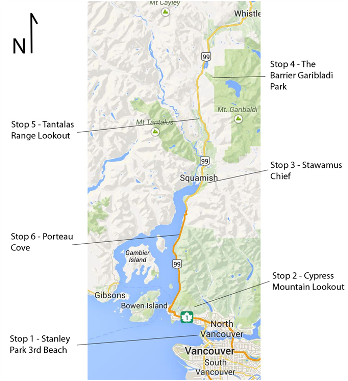 Vancouver
Vancouver
Map showing the fieldtrip locations. Stop 5 was omitted for reasons of time, and the schedule re-ordered slightly to end at Stawamus Chief (Stop 3).
The geology of the Vancouver region is impressive and inspiring, characterised by dramatic landscapes shaped by glacial and volcanic processes, and prone to potentially destructive natural hazards. During pre-fieldtrip planning, Gilley and Atchison identified a range of field locations that were fully accessible (e.g. suitable for wheelchairs with sufficient loading and unloading clearance) and ensured that enough stops provided suitable toilet facilities. The locations selected between downtown Vancouver and Whistler included coastal and beach sections, road cuts, mountain viewpoints, and National Park hiking trails. Each site offered multiple means of physically accessing and engaging with the geological setting and featured spacious, flat areas that facilitated group participation and discussion, while enabling up-close access to specific outcrops as well as small-scale features like glacial striations.
This, coupled with the development of specific course materials (including tactile maps of key locations, and text and audio versions of the field guide) ensured that the day’s activities were accessible to participants with a wide range of physical, sensory and cognitive disabilities (including limited mobility, visual and hearing impairments, learning disabilities and autism).
On the day, each student was paired with an instructor-partner, with at least one of each pair having a self-disclosed disability. Allocating partners before boarding the buses meant that everyone had someone to sit and chat with en route to the first location, and helped to initiate the social interaction that is such an important (yet often overlooked) aspect of the field experience3.
Activities were all designed to promote inquiry and to encourage participants to collaborate with, and learn from, eachother – not just in terms of their geologic knowledge, but also their personal experiences and perspectives of fieldwork, and the implications of sharing and discussing geologic content in the natural environment while focused on physical or sensory accessibility. All participants shared ideas about how to provide inclusive instruction outside the classroom for individuals with specific accommodation needs. Thus, by extending participation to both learners and instructors with disabilities – the first ever project to do so – the Sea-to-Sky Highway actively encouraged the development of a cross student-faculty community focused on the common goal of identifying guidelines for creating future opportunities for inclusive geoscience fieldwork.
Outcomes, implications
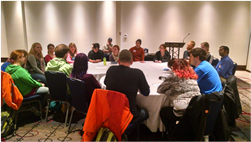 As well as experiencing a previously inaccessible geological environment, a critical outcome for participants in the 2011 Mammoth Cave study was the shared experience of being part of a group, and the creation of both a unique learning community and personal friendships, many of which have been maintained since the event.
As well as experiencing a previously inaccessible geological environment, a critical outcome for participants in the 2011 Mammoth Cave study was the shared experience of being part of a group, and the creation of both a unique learning community and personal friendships, many of which have been maintained since the event.
Picture: Student participants share their expectations and prior experiences during a pre-fieldtrip focus group.
A key aim of the current study was creating a similar, unique community - and both post-fieldwork evaluation and research data on the students’ experience suggest that the ‘Sea-to-Sky Highway’ field course was successful in this. Significantly, the students overwhelmingly identified the social aspects, (i.e., having a shared experience and forming new friendships) as particularly memorable.
The creation of a fledgling community of learners and academics dedicated to moving the ‘accessible fieldwork’ agenda forward, with a view to creating a guidance document for designing and developing such inclusive undergraduate fieldwork, is one of the experience’s most important and tangible outcomes. But it was not the only outcome. The opportunity was also of great personal significance to many, as demonstrated by this student:
“[My] over-riding memory? Lack of a cloud of panic. So, I was able to break through that barrier, and just be open to being an observational scientist without having that cloud of anxiety, with all the questions of: will I be judged? Will people think I’m ‘playing up’ my disability? Will they think I’m lazy? How am I going to access this? All those questions were gone. We were able to take a step back and be observational geoscientists, right?”
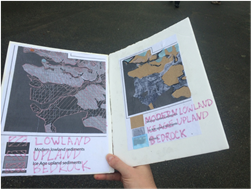 Picture: Tactile maps created for participants with visual disabilities.
Picture: Tactile maps created for participants with visual disabilities.
Learners with disabilities may not experience fieldwork in the same way as the more physically able, but they are perfectly able to participate, and by doing so, fulfil the requirements necessary to complete undergraduate geoscience degrees. The students on this fieldtrip were all highly intelligent, articulate, and deeply interested in and motivated by geology, with the potential to excel in whatever field they choose. That they should feel denied the potential to excel in geoscience – and that the geoscience profession should be denied their talent – simply because they possess a different set of abilities from the majority of their peers, is manifestly unjust.
What the project demonstrated is that fieldwork can indeed be inclusive, and that there are clear benefits when including both the learner- and instructor-perspective in designing it. To do this successfully requires a change in mind-set. Accessible fieldwork is not about achieving the impossible, but about what is possible - reducing those unnecessary aspects of fieldwork that are not directly aligned to learning objectives, and approaching design and delivery so as to enhance overall outcomes for all learners.
Getting involved
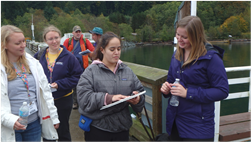 Picture: A student with a visual impairment is exploring the regional geology using tactile maps.
Picture: A student with a visual impairment is exploring the regional geology using tactile maps.
If you want to learn more about participating in or providing an accessible geoscience field course, please contact the International Association for Geoscience Diversity (IAGD) at [email protected] or visit www.TheIAGD.org. The IAGD are particularly keen to encourage international collaboration in guidance aimed at higher education institutions.
The Society is organising a one-day meeting at Burlington House, Friday 26 June, entitled Confronting barriers to inclusion: opening the gate to accessible fieldwork. The meeting is convened by Alison Stokes. To find out more, and to register, please go to the Events section of the website and use the calendar to find the 26 June meeting.
Acknowledgements
This project was conducted with assistance from the International Association for Geoscience Diversity (IAGD) and supported by the National Science Foundation (NSF) GEO-1441185, the Society of Exploration Geophysicists (SEG), and the Geological Society of America (GSA) On to the Future Program.
References
- Hall, T., Healey, M. & Harrison, M. (2004) Fieldwork and disabled students: discourses of exclusion and inclusion. Journal of Geography in Higher Education, 28, 255-280. DOI: 10.1080/0309826042000242495.
- Aitchison, C.L. (2011). The significance of access: Students with mobility impairments constructing geoscience knowledge through field-based learning experiences. (Doctoral Dissertation). Ohio State University, Columbus, OH.
- Petcovic, H.L., Stokes, A. & Caulkins, J.L. (2014) Geoscientists' perceptions of the value of undergraduate field education. GSA Today, 24(7), 4-13. DOI:10.1130/GSATG1936.A.1.
*Alison Stokes is Lecturer in Earth and Environmental Science Education, Plymouth University ([email protected]). Christopher Atchison is Assistant Professor of Science Education, University of Cincinnati, and Executive Director of the International Association for Geoscience Diversity ([email protected])